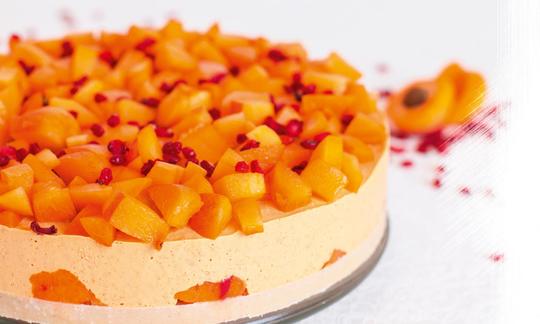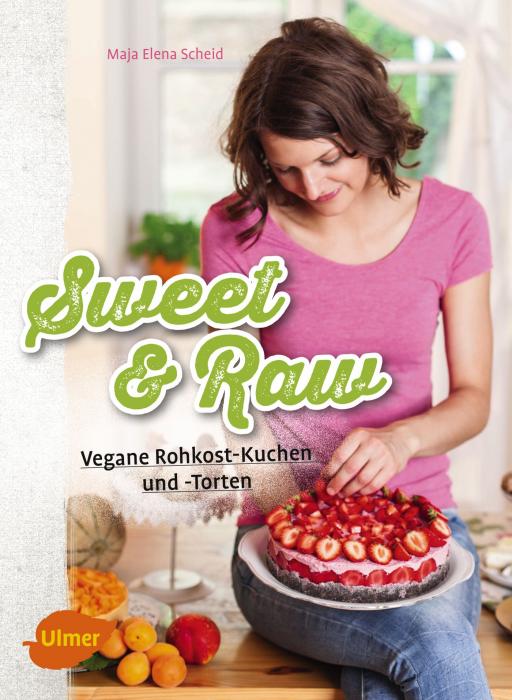Apricot Cream Cake with Cashews or Macadamia Nuts
vegan
Ingredients (for servings, )
| For the bottom layer | |
|---|---|
| ⅛ | Vanilla pod (also Bourbon vanilla, organic?) (0.01 oz) |
| 7 ⅔ oz | Cashew nuts, raw? organic? (cashew nuts) |
| 4 ⅓ oz | Coconut flour, raw? organic? |
| 1 tsp | Lemon peel, raw (organic?) (0.07 oz) |
| 80 ml | Coconut oil (coconut oil, coconut fat, organic?, raw?) (2.6 oz) |
| For the apricot cream | |
| 3 cup, sliced | Apricots, raw (organic?) (17 oz) |
| 5 ½ oz | Cashew nuts, raw? organic? (cashew nuts) |
| 175 ml | Maple syrup (organic?, raw?) (8.2 oz) |
| 50 ml | Coconut oil (coconut oil, coconut fat, organic?, raw?) (1.6 oz) |
| 1 tbsp | Psyllium husks (raw, organic?) (0.23 oz) |
| Layering the cake | |
| 8 | Apricots, raw (organic?) (9.8 oz) |
Equipment
- blender or hand-held blender / immersion blender or shredder
- freezer or refrigerator
- baking pan (springform pan)
Type of preparation
- chop or grind
- food preparation without heating
- blend
- cool
- meld
- season to taste
Preparation
For the bottom layer
Cut the vanilla bean pod in half and use a knife to scrape out the amount called for in the recipe, or somewhat more if you prefer. Finely grind the cashews, coconut flour, vanilla, and lemon peel in a blender. Add the coconut oil and blend briefly until the mixture is smooth.The original recipe for the bottom layer of the cake is on page 78 of the same cookbook.
We have intentionally redcued the amount of coconut oil.
Pour the batter into a springform pan (diameter: 21 cm) that is lined with parchment paper and smooth out until even. Place in the freezer and leave it there while you are making the cream.
For the cream
Wash the apricots and remove the pits. Place all of the ingredients except for the psyllium in the blender and blend until smooth. Taste the cream and if desired add a little coconut palm sugar. (The sweetness of apricots can vary greatly.) Add the psyllium and blend until it is mixed in.For the cream, we have intentionally reduced by a third of the coconut oil that is called for in the original recipe.
The author Maja Elena Scheid uses ¾–1 cup maple syrup.
Layering the cake
When the bottom layer is relatively firm, remove from the freezer and arrange apricot slices on top so that they are close together.Pour the cream on top of the apricot slices and spread out evenly. Place the cake in the refrigerator or freezer again to cool. As soon as it is firm, remove the ring and decorate the cake with apricots or another type of fruit.
The author recommends that you cool the cake 2–4 hours in freezer or 5–8 hours in the refrigerator.
|
Nutritional Information per person
Convert per 100g
|
2000 kcal | |
|---|---|---|
| Energy | 447 kcal | 22.4% |
| Fat/Lipids | 30 g | 43.3% |
| Saturated Fats | 14 g | 71.9% |
| Carbohydrates (inc.dietary fiber) | 43 g | 15.9% |
| Sugars | 26 g | 28.5% |
| Fiber | 7.5 g | 30.2% |
| Protein/Albumin | 10 g | 20.9% |
| Cooking Salt (Na:12.8 mg) | 33 mg | 1.4% |
| Essential micronutrients with the highest proportions | per person | 2000 kcal | |
|---|---|---|---|
| Min | Copper, Cu | 0.99 mg | 99.0% |
| Min | Manganese, Mn | 1.6 mg | 81.0% |
| Prot | Tryptophan (Trp, W) | 0.14 g | 56.0% |
| Prot | Threonine (Thr, T, irreversibly transaminated) | 0.38 g | 41.0% |
| Elem | Phosphorus, P | 268 mg | 38.0% |
| Elem | Magnesium, Mg | 139 mg | 37.0% |
| Prot | Valin (Val, V) | 0.59 g | 36.0% |
| Prot | Isoleucine (Ile, I) | 0.41 g | 33.0% |
| Prot | Leucine (Leu, L) | 0.77 g | 32.0% |
| Fat | Linoleic acid; LA; 18:2 omega-6 | 3.2 g | 32.0% |
Detailed Nutritional Information per Person for this Recipe
The majority of the nutritional information comes from the USDA (US Department of Agriculture). This means that the information for natural products is often incomplete or only given within broader categories, whereas in most cases products made from these have more complete information displayed.
If we take flaxseed, for example, the important essential amino acid ALA (omega-3) is only included in an overarching category whereas for flaxseed oil ALA is listed specifically. In time, we will be able to change this, but it will require a lot of work. An “i” appears behind ingredients that have been adjusted and an explanation appears when you hover over this symbol.
For Erb Muesli, the original calculations resulted in 48 % of the daily requirement of ALA — but with the correction, we see that the muesli actually covers >100 % of the necessary recommendation for the omega-3 fatty acid ALA. Our goal is to eventually be able to compare the nutritional value of our recipes with those that are used in conventional western lifestyles.
| Essential fatty acids | per person | 2000 kcal |
|---|---|---|
| Linoleic acid; LA; 18:2 omega-6 | 3.2 g | 32.0% |
| Alpha-Linolenic acid; ALA; 18:3 omega-3 | 0.03 g | 1.0% |
| Essential amino acids | per person | 2000 kcal |
|---|---|---|
| Tryptophan (Trp, W) | 0.14 g | 56.0% |
| Threonine (Thr, T, irreversibly transaminated) | 0.38 g | 41.0% |
| Valin (Val, V) | 0.59 g | 36.0% |
| Isoleucine (Ile, I) | 0.41 g | 33.0% |
| Leucine (Leu, L) | 0.77 g | 32.0% |
| Lysine (Lys, K, irreversibly transaminated) | 0.53 g | 29.0% |
| Phenylalanine (Phe, F) | 0.40 g | 26.0% |
| Methionine (Met, M) | 0.18 g | 19.0% |
| Vitamins | per person | 2000 kcal |
|---|---|---|
| Vitamin B2 (Riboflavin) | 0.35 mg | 25.0% |
| Vitamin K | 15 µg | 21.0% |
| Vitamin B1 (Thiamine) | 0.20 mg | 18.0% |
| Vitamin B6 (pyridoxine) | 0.21 mg | 15.0% |
| Vitamin B7 (Biotin, ex vitamin H) | 6.3 µg | 13.0% |
| Vitamin C (ascorbic acid) | 8.2 mg | 10.0% |
| Vitamin B5 (Pantothenic acid) | 0.52 mg | 9.0% |
| Vitamin A, as RAE | 74 µg | 9.0% |
| Vitamin E, as a-TEs | 1.0 mg | 9.0% |
| Vitamin B9, B11 (Folate, as the active form of folic acid) | 18 µg | 9.0% |
| Vitamin B3 (Niacin) | 1.3 mg | 8.0% |
| Essential macroelements (macronutrients) | per person | 2000 kcal |
|---|---|---|
| Phosphorus, P | 268 mg | 38.0% |
| Magnesium, Mg | 139 mg | 37.0% |
| Potassium, K | 613 mg | 31.0% |
| Calcium, Ca | 52 mg | 6.0% |
| Sodium, Na | 13 mg | 2.0% |
| Essential trace elements (micronutrients) | per person | 2000 kcal |
|---|---|---|
| Copper, Cu | 0.99 mg | 99.0% |
| Manganese, Mn | 1.6 mg | 81.0% |
| Zinc, Zn | 2.9 mg | 29.0% |
| Iron, Fe | 3.3 mg | 23.0% |
| Selenium, Se | 7.7 µg | 14.0% |
| Iod, I (Jod, J) | 3.0 µg | 2.0% |
| Fluorine, F | 0.67 µg | < 0.1% |
"Sweet & Raw" features healthy raw vegan, gluten-free cakes, tarts, cupcakes, and more. For raw foodists, vegans, and all fans of natural, sweet baked goods.
Since this book is written in German, a description is omitted here. If you are interested, please switch to German in the menu.
You can use either cashews or macadamia nuts for this delicious apricot cream cake. Coconut oil and cooling give the cake the necessary firmness.
Yield: The recipe makes one cake (diameter: 21 cm).
This dessert is not raw: We have intentionally listed this recipe in the category “Vegan, cooked” because it contains a substantial amount of maple syrup. This concentrated syrup tapped from maple trees is especially popular in North America and is a vegan sweetener that is currently heated during the production process and is therefore not raw. The process came from the Indians who drilled holes in the stems of maple trees and collected the sap that was inside. During the cooking process, the sap concentrates and the typical flavor (caramelization of the sugars) develops.
Apricots: Apricots are sweet and juicy. They can be eaten raw or made into jam or other specialties. The kernels are toxic to us as they contain amygdalin. Apricots contain a wide variety of vitamins and minerals from potassium, phosphorous, calcium, magnesium, sodium, and iron to vitamin C and E and the B vitamins.
Cashews: There is hardly another food that contains a higher proportion of the essential amino acid tryptophan than cashews. Tryptophan is an essential nutrient in the production of the neurotransmitter serotonin. Cashews are also a good source of minerals such as magnesium and iron. However, cashews cannot be eaten raw as they contain the toxic oil cardol. When sold commercially, they have either been steamed or roasted and are therefore not truly raw. If “Raw cashews” is on the label, this usually just means that the toxic cardol they contain has been deactivated by steaming instead of roasting. It is only when the process is explained in detail and controlled that we can be sure the cashews are raw.
Coconut flour: Coconut flour is made by grinding and dehydrating coconut meat and then extracting the oil. This is why it is a by-product in the production of coconut milk and coconut oil. Thanks to the relatively high amounts of indigestible carbohydrates it contains, coconut flour has the highest proportion of fiber of all common flour types. Coconut flour has a somewhat sweet, nutty flavor, which is why it is an especially good choice to use in sweet dishes. And because it absorbs liquids quickly, it also works well as a binder.
Reducing the amount of oil: We have intentionally reduced the amount of coconut oil. If you don’t think it is enough, you can increase the amount a bit. If you are interested in reading more about why it is a good idea to reduce your oil intake, please see our following article: A Vegan Diet Can Be Unhealthy. Nutrition Mistakes.
Size of springform pan: For this cake, a springform pan that is about 21 cm in diameter works best.
Coconut oil and cooling time: You can also completely leave out the coconut oil in the cream, but then you will have to increase the cooling time a bit. However, it will be quicker if you put the cake in the freezer rather than the refrigerator.
Macadamia nuts: Instead of the cashews called for in the original recipe, you can use macadamia nuts if you prefer.
The apricots can also be replaced by a different type of fruit.




